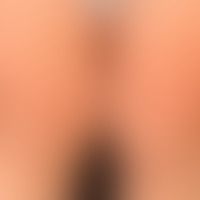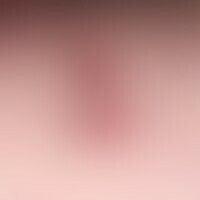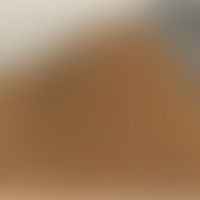Image diagnoses for "Leg/Foot"
395 results with 1158 images
Results forLeg/Foot

Hypertrophic Lichen planus L43.81
Lichen planus verrucosus with transition into a lichen palnus ulzerosus: verrucous and hyperkeratotic lichen planus of both feet and lower legs, existing for several years, and for several months flat deep ulcers without any healing tendency.

Purpura pigmentosa progressive L81.7
Purpura pigmentosa progressica (type: Purpura anularis teleangiectodes): brown-red anular, also cocard-like (ring-in-ring structure) by confluence also serpiginous foci. no significant itching. sporadically also largely faded only shadowy spots.

Pemphigus chronicus benignus familiaris Q82.8
Pemphigus chronicus benignus familiaris: migrating, circulatory plaques covered with scales and crusts

Pyoderma vegetating L08.0
Pyodermia vegetans: General view: Clearly putrid, round ulcerations as well as crusts and punctual hyperpigmentation on the right lower leg of a 17-year-old Indian woman.

Necrobiosis lipoidica L92.1
Necrobiosis lipoidica: 2-year-old, solitary, chronically stationary, approx. 3.5 x 3.0 cm in size, localized on the left lower leg, blurredly limited, brown-reddish plaque with central atrophy.

Pagetoid reticulosis C84.4
Reticulosis, pagetoid (disseminated type Ketron and Goodman): For several years slowly migrating, partly anular, partly garland-shaped, little itchy, brown-red, only minimally elevated, broadly margined plaques with parchment-like surface.

Pityriasis lichenoides chronica L41.1
Pityriasis lichenoides chronica:moderately itchy, dense, maculo-papular exanthema that has been present for several months.

Erysipelas bullous
Erysipelas bullöses: acuteareal, sharply defined, painful reddening and plaque and areal blistering in the area of the lower leg. entry portal: macerated tinea pedum. fever, chills, lymphangitis and lymphadenitis also exist.

Primary cutaneous diffuse large cell b-cell lymphoma leg type C83.3
primary diffuse diffuse large cell B-cell lymphoma leg type: for about2 years papules and nodules on the left leg of a 55 years old woman appearing in relapses. in the last weeks rapid growth of the pre-existing nodules and eruptive appearance of new nodules. initially no symptoms. since 2 months increasing tendency to dry and also weeping surface scaling. in places complete decay of the nodules.

Sarcoidosis of the skin D86.3
Sarcoidosis, plaque form: slightly pressure-painful plaques of the skin with plates with a scaly surface that can be easily distinguished from the surrounding area and can be moved on the support.

Pityriasis lichenoides (et varioliformis) acuta L41.0
Pityriasis lichenoides et varioliformis acuta. 15-month-oldchild. 0.2-0.4 cm large, symmetrically arranged, only slightly itchy, red, surface-smooth and eroded papules and papulovesicles disseminated on the trunk and extremities for a few days.

Necrobiosis lipoidica L92.1
Necrobiosis lipoidica: Waxy, reddish-brown, smooth, shiny infiltrate plates with several punched-out ulcers (after banal trauma) in type I diabetes in the area of the tibia.

Squamous cell carcinoma of the skin C44.-
Squamous cell carcinoma of the skin: ulcerated, spinocellular carcinoma of the lower leg, which has long been misunderstood as an ulcer (cruris) and thus has been treated unsuccessfully. Remarkable: Only slight pain!

Primary cutaneous diffuse large cell b-cell lymphoma leg type C83.3
Primary cutaneous diffuse large cell B-cell lymphoma leg type: For about 2 years papules and nodules on the left leg of a 55 years old woman appearing in relapses. In the last weeks rapid growth of the pre-existing nodules and eruptive appearance of new ones. Initially no symptoms. For 2 months increasing tendency to surface scaling and ulcer formation.

Lipedema R60.9
Lipedema: bilateral, initially painless, and after years of existence painful, symmetrical, initially discrete, later increasing, partly jodhpur-like fatty degeneration of the legs. the circumference of the thigh is disproportionately enlarged in comparison to the relatively slim upper body. back of the foot and toes are not swollen (Stemmersch's sign: negative). tendency tohaematomas









